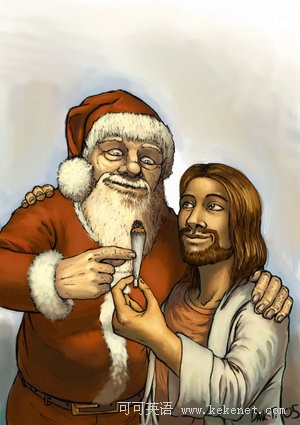(单词翻译:单击)
背景介绍
【背景】

传说圣诞老人是在数千年前的斯堪的纳维亚半岛即出现。北欧神话中司智慧、艺术、诗词、战争的奥丁神,寒冬时节,骑上他那八脚马坐骑驰骋于天涯海角,惩恶扬善,分发礼物。与此同时,其子雷神穿红衣以闪电为武器与冰雪诸神昏天黑地恶战一场,最终战胜寒冷。据异教传说,圣诞老人为奥丁神后裔。 也传说称圣诞老人由圣·尼古拉而来,所以圣诞老人也称St.Nicholas。据说他原是小亚细亚每拉城的主教,名叫圣尼古拉,死后被尊为圣徒,是一位身穿红袍、头戴红帽的白胡子老头。每年圣诞节他驾着鹿拉的雪橇从北方而来,由烟囱进入各家,把圣诞礼物装在袜子里挂在孩子们的床头上或火炉前。所以,西方人过圣诞节时,父母把给孩子的圣诞礼物装在袜子里,圣诞夜时挂在孩子们的床头上。第二天,孩子们醒来后的第一件事就是在床头上寻找圣诞老人送来的礼物。如今,圣诞老人已成为吉祥如意的象征,不仅是过圣诞节时不可缺少的人物,而且也是欢庆新年时不可缺少的人物。总之,圣诞老人已永驻人的精神世界,因为他的诸多故事大多弘扬基督精神。
11世纪末来自意大利的宗教士兵将Nicholas圣人的遗物带回意大利,并在港口城市Bari建造了一座教堂来纪念他。很快世界各地的基督教徒纷至沓来朝圣这位圣人。这些朝圣者将圣人Nicholas的故事带回他们的本土,所以有关圣诞老人的传说在各个国家都各具特色。
12世纪欧洲出现了圣人Nicholas纪念日,以互赠礼物和慈善活动为主。德国、法国、荷兰则将12月6日作为宗教纪念日,给孩子和穷人们赠送礼物。 荷兰殖民者来到美洲时,将他们的Sintirklass主教也带了去,Sintirklass身着红袈裟,骑着一匹白马。Sintirklass的美国形象后来逐渐演变成一个快乐的老精灵。起初美国作家华盛顿.欧文在他的喜剧《纽约的历史》中将他描述成一个又圆又胖的荷兰老人。
1823年,诗人Clement Moore在他的诗歌《St.Nicholas印象》中继续将Sintirklass/Saint Nicholas的形象戏剧化,这就是各位在本篇开头看到的圣诞老人。 19世纪60年代卡通制作者Thomas Nash画了一幅胖胖的、慈祥的圣诞老人作为《Harper的一周》的插图。这个圣诞老人的形象开始深深地扎根于美国人民的脑海中。随着时间的推移,圣诞老人的形象传回欧洲,传到南美洲,传遍世界各地。 许多国家都保存了他们自己有关圣诞老人的风俗和传说。在荷兰的传说中,圣诞老人Sintirklass还带了一个叫Black Peter的助手,乘着一艘船于12月6日来到。他带着一本大书,书中描述了所有荷兰小孩在过去一年中的表现。表现好的小孩就送礼物给他们,不好的小孩便让他的助手带走。 德国的圣诞老人也带着一个叫做Knecht Ruprecht、Krampus或Pelzebock的助手,肩上背着个装着礼物的大袋子,手上拿着一根棍子。好孩子可收到他的礼物,顽皮的孩子却要给教训几棍子。
意大利的圣诞老人叫La Befana ;法国的圣诞老人叫Father Christmas或Pere Noel ;瑞士的圣诞老人叫Christkindl或Christ Child;斯勘的纳维亚地区的圣诞人叫julenisse 或 juletomte ;而英国的圣诞老人和法国一样也叫Father Christmas(圣诞之父),他的形象比其它圣诞老人更庄严,更清瘦一些。北美的圣诞老人便是乘着驯鹿拉的雪橇来给孩子们送礼物的。
每年的12月25日,是基督教徒纪念耶稣诞生的日子,称为圣诞节。
从12月24日于翌年1月6日为圣诞节节期。节日期间,各国基督教徒都举行隆重的纪念仪式。圣诞节本来是基督教徒的节日,由于人们格外重视,它便成为一个全民性的节日,国家一年中最盛大的节日,可以和新年相提并论,类 是西方似我国过春节。
摘自百度贴吧
英文原文
【原文】
Christmas celebrates the birth of Christ, the Nativity of the babe in the manger whom Christians believe was the Son of God. Indeed, the very word Christmas means “Christ festival”.
Yet there can be little doubt that for many it is Santa Claus — not Jesus — who is the human face of Christmas. In fact, it is fair to say that in much of the world, Santa is better known than the Christ who gave his name to the holiday.
But how did the fat man in the Coca-Cola red-and-white suit become the symbol of Christmas? The truth is that like the Christmas story itself, the story of Saint Nicholas is a composite of history, myth, and legend.
According to tradition, he was born in Asia Minor (modern-day Turkey) in about A.D. 270. When young, he traveled to Palestine and Egypt. Not long afterward, he became a bishop. During the Roman emperor Diocletian’s bloody persecution of Christians in 303, Nicholas was imprisoned. However, when Constantine the Great became emperor in 306, he legalized Christianity and made it the official religion of the Roman Empire. Nicholas was freed.
The scribes tell us that Nicholas’s prayers and leadership during the great tribulation led many to become Christians. Nicholas continued to serve as bishop for many years. On December 6, 343, Nicholas the man died, and Saint Nicholas the legend was born.
During his lifetime, Nicholas’s reputation for generosity and kindness gave rise to stories of miracles he performed for the poor, the weak--and children. After his death, devotion to Nicholas extended to all parts of Europe. His feast day was celebrated on December 6, but his reputation as a gift-giver later became attached to the celebration of Christmas on December 25.
After the Reformation in the 16th century, Nicholas’s cult disappeared in most Protestant countries of Europe. But his legend was united with old Nordic folktales of a magician who punished naughty children and rewarded good children with presents. In England, he became known as Father Christmas. But in Holland, Saint Nicholas’ name and reputation persisted as “sinterklaas.”.
In the 17th century, Dutch colonists took this tradition with them to America. Later, Sinterklaas was adopted by the English-speaking majority as “Santa Claus.” The resulting image of a “jolly old elf” driving a sleigh with “eight tiny reindeer” crystallized in the 19th century. That was when Clement Moore wrote the now-famous poem “A Visit From Saint Nick.” And the red-and-white suit? That was created by a Coca-Cola adman in the 1930s.
Although greatly commercialized, the modern Santa Claus still embodies8 Saint Nicholas’ generosity and love for children. And for some, he still points to the Nativity of the babe in the manger, and reminds us of the reason we celebrate Christmas.
中文译文
【中文译文】
圣诞节是庆祝基督——这名被基督徒视为上帝之子的婴儿在马槽里的诞生。的确,“圣诞节”这个词意思就是“基督的庆典”。然而,可能有许多人会有点疑惑,圣诞节的代表人物竟是圣诞老人,而不是耶稣。事实上,这样说也不为过:在世界上许多地方,圣诞老人要比赋予该节日名称的基督还更出名。
但是,那个穿着一套可口可乐红白颜色衣服的胖子是怎么成为圣诞节的象征的呢?事实上,跟圣诞节本身的故事一样,圣人尼古拉的故事,也是集历史、神话和传说于一身。
按照传统的说法,公元270年,尼古拉生于小亚细亚(现在的土耳其)。年轻时,他曾经到巴勒斯坦和埃及旅行。不久以后,他成为了一名主教。
公元303年,罗马皇帝戴克里先血腥迫害基督徒期间,尼古拉被捕入狱。然而,公元306年君士坦丁大帝登基称帝,他使基督教合法化,并使之成为罗马帝国的国教。尼古拉也获释放。
据史书记载,尼古拉在受难期间的祈祷和领导让很多人皈依成为基督教徒。(出狱后)尼古拉继续担任主教多年。公元343年12月6日,真人尼古拉去世,然而圣人尼可拉的传说诞生了。
尼古拉在世时慷慨仁慈的名声衍生出他为穷人、弱者和孩子创造奇迹的许多故事。尼古拉死后,人们对他的挚爱延伸到欧洲各地。节日仪式定在12月6日举行,但是他身为“赠礼者”的声望,后来却与12月25日圣诞节的庆典扯上了关系。
16世纪宗教改革运动以后,对尼古拉的膜拜便在多数欧洲新教国家销声匿迹了。但是有关他的传说却跟一个北欧民间故事结合了起来,故事中有位魔术师,他爱惩罚顽皮的孩子,并送礼物奖励好孩子。在英格兰,尼古拉成为家喻户晓的圣诞节之父。而在荷兰,圣人尼古拉的名声依旧以“Sinterklaas”的名字流传。17世纪,荷兰的殖民者将这个传统带到美洲。后来,“Sinterklaas”为多数说英语的人民所采用,并改成了“Santa Claus”。他最后的形象──“快乐的老矮人”驾着“八只小驯鹿”拉的雪橇──是在19世纪开始变得明确具体起来的。摩尔(Clement Moore)就在那时写了《圣人尼克的来访》这首闻名至今的诗。还有那件红白套装呢?那是在20世纪30年代,可口可乐公司的广告商创造出来的。
尽管现代的圣诞老人已经被高度商业化,他仍旧表现了圣人尼古拉的宽大胸怀和对孩子们的爱。对某些人来说,他仍然象征着马槽里圣婴的诞生,并让我们想起庆祝圣诞节的缘由。
词汇讲解词汇讲解:
1. manger(马、牛的)食槽
如:He put some grass in the manger.
他在食槽里放了些草。
2. composite 合成物, 复合材料
如:In microwave system the separate input from various sources must be brought together to give a composite input which is then transmitted and received by radio.
在微波系统中, 来自各处的分散的输入必须被汇集在一起, 以形成一个综合的输入, 然后由无线电发送和接收。
3. persecution 迫害,烦扰
如:The Jews suffered terrible persecution under Hitler's rule.
犹太人在希特勒的统治下受到残酷的迫害。
Christian martyr. A student of the Apostle John, he was burned at the stake during a period of persecution of Christians in Smyrna.
圣·波利卡普基督教殉道者。阿波斯尔·约翰的学生, 在士每拿地方对基督徒的迫害期间被焚死
4. persist 坚持,固执,持续
如:If you persist in breaking the law you will go to prison.
如果你再继续违法的话, 你会坐牢的。
The cold weather will persist for the rest of the week.
这种寒冷的天气将持续到本周末。
5. crystallize(使)具体化, (使)结晶,
如:She's trying to crystallize her ideas into a practical plan.
她试图把自己的想法订成可行的计划。
Reading your book helped crystallize my views.
我阅读你的著作有助於澄清我的思想.
(可可英语版权所有,未经允许请勿转载)


